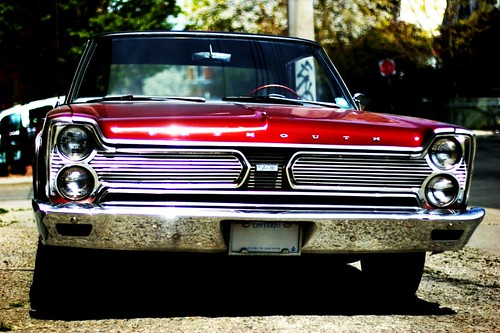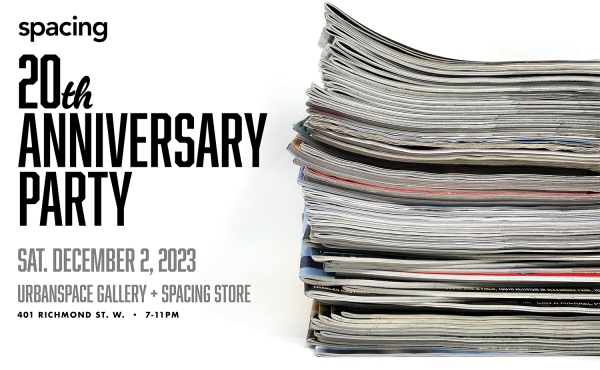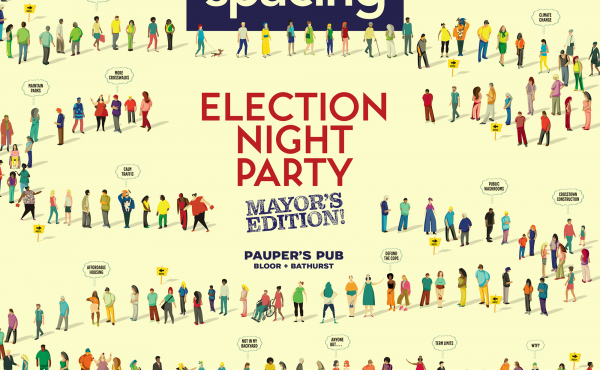
For faithful readers of this blog, you have probably noticed a bit of a slow-down in the amount of content that appears on a daily basis. The editors and writers are not being lazy — rather, we’ve been working hard to put the final touches on our Spring 2008 issue. You’ll start to see us return to our regular rate of posts within a week or so.
The new issue of Spacing is focused on the car and the city. Our contributors examine electric cars, the City’s green fleet, why kids no longer walk to school, the effects of free parking on the built form, and what its like not to have a driver’s license.
The issue also contains three excellent features: Spacing associate editor Shawn Micallef tries to reconcile his car-oriented youth in Windsor, Canada’s Motor City, with his much more urban and car-free life; Dylan Reid, another Spacing associate editor, examines the looming economic reality that the automobile faces in the 21st century; and John Lorinc delves into the personal and political conflicts that have plagued the Corus building’s rise on Toronto’s waterfront.
Also in this issue: why squirrels rule; the comeback of the clothesline; the scourge of drive-thrus; and why the CN Tower’s light installation should be permanent.
This issue should start to reach the mailboxes of our subscribers (and newsstands across the city) by April 14th. More details will follow including a date for our customary release party.
photo by Miles Storey



15 comments
How about an issue about Recreational, Sports, and Leisure facilities and the City?
Spacing issue #3 was Work & Play in public space. But thanks for the idea, Chris.
I’d like to write an article called “Why the CN Tower’s light installation (and those at Rogers Centre and City Hall) is an abomination and an blight on the architecture it illuminates.”
I get fairly animated about this because I fear the day that all our great buildings randomly change colour solely because the tech is cheap, Dubai is cool and imitation is in the nature of a Torontonian. Sure it’s architecturally bankrupt, but on St. Paddy’s Day we can make it green!
I’m in the minority on this one…
I think so, Josh. The CN Tower is my near-favorite Toronto building (that is, kinda sacred) and I think I”m sensitive to things garish, but I like the lights. Seems lots do, which I’m surprised at.
It’s good that there are those who don’t because it makes the rest of us examine why we do.
The walking children thing I find really interesting. I think there was a post here last year about a study that tracked the amount of car traffic to drive kids to and from school, often only a block or so, the numbers were staggering. And some schools were hiring traffic cops to ticket idling cars and traffic jams.
I live near a school and the car traffic blows my mind. There are kids that are driven only a block. And what is the biggest danger to those that walk to school…speeding cars driven by crazed parents taking their ids to school.
If anybody can recall that post (and if not here where) I would appreciate it.
Sounds like an awesome issue. Can’t wait to get a copy.
Looking forward to the article on squirrels. I’ve often seriously considered studying the plight of the urban squirrel. Raccoons too.
This month’s Urban Decoder in Toronto Life included the question: “Is it illegal to kill raccoons?” …..
Do an article on the possible effects of the recently legalized electric bikes that are showing up!
I was always amazed by how much the traffic seemed to lighten up once school was over. I noticed on the few times I would drive downtown on a weekday morning, during the summer traffic was rarely an issue but once the first day of school started, it seemed like traffic was up 200%.
I’ve only read the Summer and Fall 2007 issues of Spacing. Afterward I’ve become a regular user of this blog/newswire site. I really enjoy Spacing. I think it’s a wonderful magazine/site and plays to a fabulous niche market that wasn’t properly tapped into before. At the same time, urban issues isn’t a niche market. Since we are all part of this city, it only makes sense for people to have (or develop) an interest in our public spaces.
But just something to consider. I passed along the Water issue to my sister and she made an interesting comment. I’m sure it’s come up before but I thought I’d throw it out there anyway. She said while the concept is great (i.e. informing readers about more obscure city topics), having a specific focus for every issue makes it appear like the editorial staff is going to very far lengths to come up with story ideas revolving around the chosen theme. She said she would prefer if Spacing just wrote about a wider variety of topics instead of trying so hard to pinpoint something specific to talk about. I could see what she meant because I definitely felt like the Fall 2007 issue was a bit silly – “Is Toronto ready to be a green city?” I believe Spacing is already a magazine that promotes sustainable living and frames their stories around the environment as a natural style. Why dedicate an entire issue to it when it is already a common component to your entire magazine?
Anyway, perhaps when Spacing expands to more issues per year, the magazine will lose the constant theme-bent and just be comfortable knowing that urban issues is already the focus that ties everything together.
We’ve thought about that Heather, but it is sort of interesting to be able to “mine” the topic for stories that might be overlooked if there was no theme and it was general public space. We like to set out the idea, and see what our writers pitch (we don’t think up all or most of the article topics — our writers do) — and by using a theme, it gives them something specific to think about (and I would argue, we sometimes stretch the theme and aren’t too strict on its meaning).
And the theme is just the middle section, the front and back sections are still general interest.
What in particular about the green issue was silly, other than the tag-line? Articles in particular?
Shawn:
I understand most of the time it’s the writers who come up with the story ideas, but it is the editorial staff that approves of them…. right…? Haha.
And I know the front and back sections are still of general interest, which I appreciate. I think the front and back sections are particularly well done. Maybe even better than the middle section because they touch on things that are a bit quirkier/more original.
Also, I should probably clarify what I mean by “a bit silly.” I mean it in the sense that a green issue is just so obvious. I felt the same way when Toronto Life came out with their “first ever green issue” last year. Even Vanity Fair doing an “annual” green issue already seems outdated/overplayed. I think being conscious of the environment is finally at a place where it can be encompassed in all stories–business, food, art, sports, etc.–that it doesn’t need an entire issue dedicated to it anymore. Granted, there should still be more narrow environment-specific stories, but the media should be constantly aware of the environment in general, and I think most media is moving toward doing so.
And one other reason why I think the issue in general was “a bit silly.” Maybe I shouldn’t be assuming this, but I would think the readers of Spacing are already environmentally-conscious. So OK. You put out a green issue, but some ideas/stories have already been done a million times. So what’s the fresh angle? How are you going to give us something new and interesting to think about? Here are some of the articles I thought have been done before and how I think you could have angled it instead:
1. Cover story – exclusive interview with David Suzuki and David Miller. Pretty boring. We all know Suzuki and Miller. We read about them in the Star, the Globe and Mail, we see them on CBC. Is it really all that “exclusive” when hundreds of other media outlets have interviewed them about all of this before? It may have been more interesting to do a cover story on some grassroots Toronto groups who are leading the fight against climate change RIGHT NOW. (Cyclists come to mind, at the moment–Bike Pirates.) Personally, I don’t think Toronto is leading the fight. I think many American and European and even other Canadian cities are doing it better than Toronto. But I also dislike negative pieces without any constructive critiques/solutions attached to them.
2. Toronto vs. Other Cities – This chart did NOTHING for me. All those numbers don’t really translate into anything tangible. For example, instead of just listing off population and geographic size, maybe it would have been more effective if you told readers how many people live within every square kilometre in each city. You need to put a quirky spin on what the numbers mean–like 7 million trees can clean enough air for 600 people or something like that (clearly I’m just making stats up).
3. We Need to Be Air-Heads – It was a good story but I feel like it was a missing a human element. This is another problem I find with many Spacing articles. Where are the people in the stories? This story would have been a lot better if the writer had given me two or three characters to identify with–people who’ve lived in Toronto, have tried to maintain a healthy lifestyle but are facing health problems because of the air. Or people who’ve moved to Toronto and have seen their health deteriorate from air pollution. Maybe this is difficult to do because health problems can’t be directly linked to merely air pollution, but… that’s the thing. Maybe it could be! Or maybe we should be looking at finding a direct link.
What stories I really did enjoy and found were fresh:
1. Taking it to the street – So on point with what I think Spacing is all about.
2. The gravel is always greener – Who knew parking lots could be greened!? This was a really interesting story, especially since it was balanced with why there are difficulties to doing this.
3. You are where you eat – I really, really liked this story. I instantly went to look up if there was a community garden in my area. The story was informative, it was about something unique, and there were (some) people in it so readers could identify with wanting to be engaged in the projects too.
Anyway, I understand why Spacing theme their issues (exactly the reason you gave is what I was thinking: giving writers something specific to think about)… But just like I said before, I don’t think it’ll be as necessary anymore when Spacing expands its number of issues per year, as I’m sure it will.
Heather seems to applying for an editor’s position.
If I’m to believe the hype (and I do) Spacing is picking up new readers and converts all the time. So, heather suggests NOT doing some articles on topics because “readers of Spacing are already environmentally-conscious” is a navel-gazing perspective to have on the magazine. While I understand her points, just because they don’t interest her doesn’t mean they won’t attract other people.
I thought it was great to have Suzuki comment on Toronto’s green issues since we only hear him talk about global or national issues.
And I’m a sucker for the themes.
So take her comments with a grain of salt and keep one foot with your loyal readers and one foot out there attracting folks from the mainstream.
LOL. I’m not applying for an editor’s position although I know my comments are obviously editorial-heavy.
I’m just into sharing thoughts and ideas to make great products even greater. I know not everyone shares my opinion, but I more than appreciate vibrant discussion and opposing viewpoints.
Molly:
Also, just to point out, my suggestion to eventually start moving away from theme issues is with the idea in mind to attract even more new readers in greater numbers. And I’m not saying Spacing doesn’t already. After all, I think it’s obvious from my positive comments and the fact that I think it will expand to more than three issues per year is a sign that I think the magazine is really well done. I just think a broader approach could perhaps reach even more new people than it is already.
And I also said that I probably shouldn’t assume all readers (or converts) to Spacing are environmentally-conscious. But my real point was always trying to develop fresh, new angles, which I think all readers of any magazine appreciate.